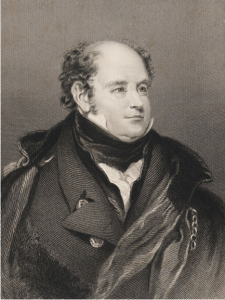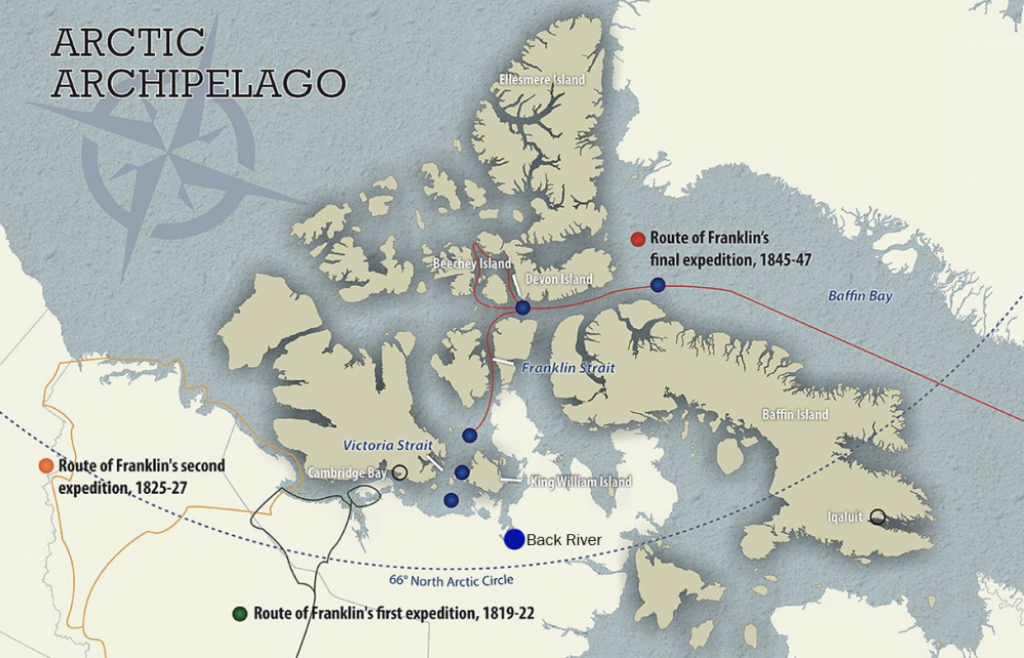What happened?
- Sir John Franklin (image below) was a British Royal Navy officer and Arctic explorer. In 1845 he left England in search of the Northwest Passage, a sea route from the Atlantic Ocean to the Pacific Ocean through the Arctic Archipelago of Canada.

Thomas Phillips, unknown. Engraving of Sir John Franklin, 1845. Engraving on paper. D. Brogue. NATIONAL PORTRAIT GALLERY OF AUSTRALIA.
- The expedition members spent the winter of 1845-1846 at a camp on Beechey Island, before heading south to King William Island (map below). Before reaching King William Island, the two ships, the HMS Erebus and the HMS Terror, became trapped in sea ice in September of 1846. The ships remained trapped, even during the summer months, so in April 1848, the expedition members abandoned them and began to walk to the nearest European settlement at Back River (map below), which they never reached.

Map of the Arctic Archipelago in northern Canada showing the routes of Sir John Franklin’s three Arctic expeditions. The route of his final and unsuccessful expedition is shown in red. The blue dots represent important points along the route: the camp at Beechey Island; where the ships became trapped in ice north of King William Island; where the HMS Terror was found off the coast of King William Island; where the HMS Erebus was found a little south of that; and the European settlement at Back River (from Kylie 2016, Canadian Geographic).
How is this related to climate?
- The climate of the Arctic played a major role in this disastrous expedition. Researchers have determined that the expedition took place at the end of one of the most climatically unfavorable periods in the last millennium.
- In order to conclude this, researchers took ice cores from two different sites in the Canadian Arctic to reconstruct the climate record.
- They looked at the percentage of melt layers in the ice cores, which shows how warm the summers were, and saw that the expedition took place during a period in which there was very little summer melt.
- They also looked at the ratio of oxygen isotopes in the ice cores as an indicator of past temperatures and saw that the years preceding the expedition were exceptionally cold.
- It is important to note that in the mid to late 1800s, around the time of the expedition, global temperatures were rising as the Little Ice Age was coming to a close. However, the Canadian Arctic had an anomalous period of exceptionally cold summers for around 50 years at the beginning of the 19th century, showing that overall trends in global climate do not always correspond to all regional climate patterns.
- In order to conclude this, researchers took ice cores from two different sites in the Canadian Arctic to reconstruct the climate record.
References and additional resources
- Bayliss, R. “Sir John Franklin’s Last Arctic Expedition: A Medical Disaster.” Journal of the Royal Society of Medicine, vol. 95, no. 3, 2002, pp. 151–153. DOI: 10.1258/jrsm.95.3.151.
- “Captain Sir John Franklin, KT, KCH, KRG, DCL, FRS & C. Commander of the Arctic Expedition, 1845.” National Portrait Gallery of Australia. n.d. https://www.portrait.gov.au/portraits/2012.70/captain-sir-john-franklin-kt-kch-krg-dcl.
- “Climate Model Simulations of the Last 1,000 Years.” National Oceanic and Atmospheric Administration. (n.d.). https://www.ncdc.noaa.gov/global-warming/last-1000-years.
- Edinburgh, T. and Day, J. J. “Estimating the Extent of Antarctic Summer Sea Ice During the Heroic Age of Antarctic Exploration.” The Cryosphere, vol. 10, no. 6, 2016, pp. 2721–2730. DOI: https://doi.org/doi:10.5194/tc-10-2721-2016.
- History.com Editors. “Northwest Passage.” History. 2018. https://www.history.com/topics/exploration/northwest-passage.
- Krock, L. “Tracing the Routes.” PBS Nova. 2006. https://www.pbs.org/wgbh/nova/arctic/expe-nf.html.
- Kylie, A. “Archaeologists to Resume Search for Sir John Franklin’s HMS Terror.” Canadian Geographic. 2016. http://www.canadiangeographic.ca/article/archaeologists-resume-search-sir-john-franklins-hms-terror.
- National Maritime Museum. “Exploring Antarctica – A Timeline.” Royal Museums Greenwich. (n.d.). https://www.rmg.co.uk/explore/antarctic-exploration.
- National Maritime Museum. “What Happened to HMS Erebus and Terror?” Royal Museums Greenwich. 2015. https://www.rmg.co.uk/discover/explore/john-franklin-final-north-west-passage-expedition-1845.
- Raymond, S. “A Very Special Piece of Paper.” Canadian Museum of History. 2018. https://www.historymuseum.ca/blog/a-very-special-piece-of-paper/.
- Serreze, M. C., & Barry, R. G. “Processes and Impacts of Arctic Amplification: A Research Synthesis.” Global and Planetary Change, vol. 77, no. 1–2, 2011, pp. 85–96. DOI: https://doi.org/10.1016/j.gloplacha.2011.03.004.
- Sutherland, P. D., editor. Franklin Era in Canadian Arctic History, 1845-1859. University of Ottawa Press, 1985.
- “The Arctic: Exploration Timeline.” Woods Hole Oceanographic Institute. 2006. http://polardiscovery.whoi.edu/arctic/timeline.html.
- “Understanding NSF Research: Arctic & Antarctic.” National Science Foundation. (n.d.). https://nsf.gov/news/overviews/arcticantarctic/index.jsp.
- Walker, N. “Remembering Inuit Oral Historian Louie Kamookak.” Canadian Geographic. 2018. https://www.canadiangeographic.ca/article/remembering-inuit-oral-historian-louie-kamookak.
